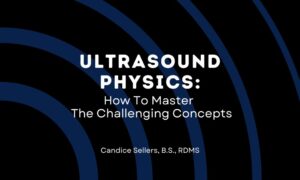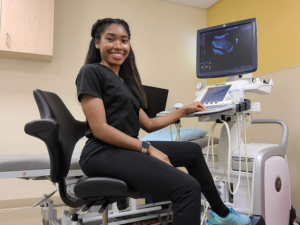I clicked submit on the SPI physics exam and ran out the the room. The test proctor handed me a piece of paper with a huge scared looking picture of myself taken before the exam, my ARDMS number and the results of my SPI examination.
My hand shook as I took hold of that paper and ran to my car to read it. PASS! I cried in relief.
Passing the Sonography Principles and Instrumentation Exam
Physics was NOT my strong suit and I was worried about how I would ever pass a board examination on something so tough. If you had told me just a few months before I would be staring at a computer screen taking a physics exam I probably would have laughed at you. But if I can do it, so can anyone! Here are a few helpful tips I used and gathered from other sonographers who saw that “pass” after the exam.
Break the SPI Down to 9 Manageable Steps
Get a review book
There are many options out there and different ones are preferred depending on your learning style. If money is tight look for used or rental books. There are choices in which author you go with. Read the reviews to see which would be best for you. But, I would insist one of these books are non-negotible and necessary to passing. Try to go through each chapter, and take notes methodically. The concepts build so understanding the basics will help. Make sure whichever book you choose has practice tests and questions.
Take mock exams
The SPI is written in a tricky way that can seem like a whole other language if you aren’t used to the wording. Remember those pesky word math problems in elementary school? You’ve just unlocked a whole other level with ultrasound physics. So practice is key. Try to isolate what exactly the question is asking and what key concept the writers are trying to solicit from you. Make sure you know ALL words that can mean the same thing. They like to change up vocabulary to make sure you understand completely.
Understand relationships
Thankfully for a lot of people, the SPI is not too math heavy. So don’t stress being good at your times tables. Worry more about understanding the concepts and how they relate to each other. Wavelength related to frequency, PRF and the Nyquist limit. Resolutions, artifacts, formulas, doppler and aliasing. All of the concepts that help you scan better are what they will test you on.
Units
This is so important to know for the test! Many of the multiple choice answers can be eliminated simply because the units are wrong. So know what each concept is measured IN, what units would be out of range, and you will be a leg up.
Use time scanning to help you memorize
While scanning, play around with doppler and frequencies. Try scanning without gel and think about the impedance difference. Change the sector width or the write/read zoom and notice how it slows or speeds your machines’ temporal resolution. Use a cysts posterior enhancement, a gallbladder stone’s absorption creating a posterior shadow or a baby’s cranium edge shadow to think about refraction. Increase your scale and see what happens to color demonstrated in the medial kidney. All these real life applications will help you remember when you are sitting in front of that computer screen trying to remember during your test.
Attend a conference
While I never got to personally attend a conference for physics, I have spoken to sonographers who pointed to the conference as the sole reason they passed the SPI. The conferences are taught by physics leaders in the field of sonography and usually the same people that write the textbooks, so getting it explained first hand can be like a Ted talk mixed with a master class in helping you understand the hard concepts. Although at times a costly option, with the onset of COVID the conferences are now more accessible than ever being offered online as well as in person! Never been an easier time to access this resource.
Make flashcards and run through them often
I made flashcards and study guides on every scrap piece of paper and would pop quiz myself at random times. Sitting at a stop light, first waking up in the morning, while brushing my teeth at night. Repetition often will help you retain. Also drawing pictures can help your brain connect the idea with the concept. Get creative with it and it will stick easier.
Use logic
There will be things you don’t know. No matter how much you study there will be something that still throws you for a loop. Don’t let it derail you. You can flag something to come back to it, or go with your gut instinct. But if you have studied at all and prepared you probably know more than you feel like you do. At least narrow it down to two answer choices. And then you have a 50/50 shot. Sometimes the test answers itself in subsequent questions. So remember what the question was and the answer may come in another question. However, don’t leave anything blank though because it will automatically be marked wrong.
Stay hopeful
Sometimes getting in your head and not trusting yourself can be your own downfall. If you don’t pass the first time the printout paper gives you a breakdown of each concept and how well you scored. This can be a guide to passing it the next time. Make your weaknesses your strengths! Brush up on what you score low in and nothing is truly lost in a fail. You really just learned how to succeed better the next time. Study hard and the test will seem easy by comparison. You can definitely beat this test and be on your way to being an accomplished sonographer.













